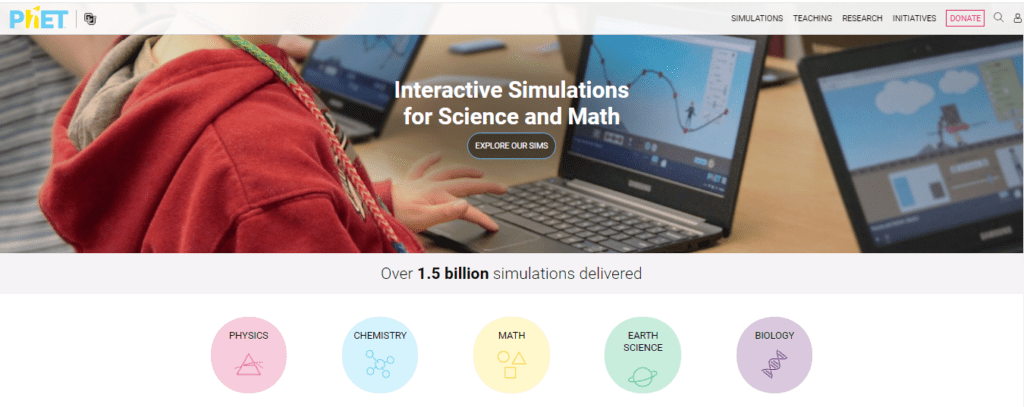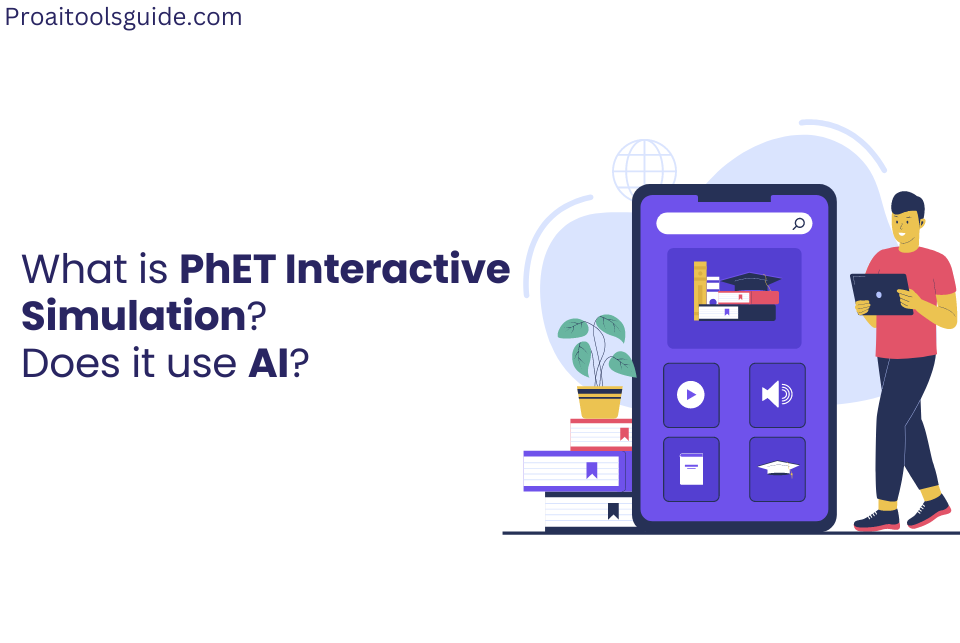
Do you find the concepts of Physics, Chemistry, and Biology boring? If your answer is yes, then your answer is going to change very soon. PhET interactive simulations have the power to make every boring or bouncing concept interactive. So your concepts will become clear in a quick and very funny way.
Nobel Laureate Carl Wieman started this simulation in 2002 at the University of Colorado. He did this to make learning interactive, funny, and free of cost, and to sharpen learners’ minds.
However, people have a lot of questions about this simulation. The biggest question is, does PhET Interactive Use AI?
Let’s get answers to these questions and go into this simulation more deeply.
What Are PhET Interactive Simulations?
PhET (Physics Education Technology) interactive simulations are basically software or tools. They help learners understand the concepts of science (Physics, Chemistry, Biology, Mathematics, etc.) in an interactive and funny way. PhET simulations help students from elementary school to university master the key scientific concepts.
Science students must work hard to understand electricity, magnetism, waves, or other physical or mathematical concepts. These interactive simulations explain these complex concepts intuitively and engagingly by showing proper experiments on screen.
Key Features of PhET Interactive Simulations?
- Interactive Learning Environment
PhET interactive simulations allow students to conduct experiments in a virtual environment, removing real-world barriers. Students can explore the complete physics of the world around them. Ranging from electromagnetic fields to wave interference, even without the fear of breaking equipment or making mistakes.
Example Simulation: Wave Interference In this simulation, students can control variables like frequency and amplitude to visualize how waves interact. Adding a second wave source allows them to observe constructive and destructive interference in real-time.
- Understand the Real-World Applications
Science becomes boring until one understands the concept of an experiment. If you discover how the experiment’s formula is made, you will see how the theories of light and waves work before your eyes. These PhET interactive simulations help learners understand complex formulas and theories deeply with the help of simulations. All the queries of “What” and “If” of these students are solved in one go. Moreover, they offer an easy way to visualize and manipulate variables that might be difficult to experiment with.
Experiment: Students can simulate how electricity is generated from a moving magnet. Using this they can learn the key concepts of electromagnetism without a lab setup.
Scientifically Grounded and Research-Based
The PhET team uses cognitive science, multimedia design, and discipline-based education research to develop simulations. Consequently, these simulations ensure that students deeply understand the subject.
PhET in the Classroom: Versatile Use Cases
Exploratory Learning: “Sandbox Environment”
| Aspect | Explanation |
| Description | Students are given a simulation without specific instructions, allowing them to explore and experiment freely with different variables. |
| Purpose | To encourage inquiry-based learning where students learn by doing, discovering new concepts as they manipulate the simulation. |
| Example | In the Wave Interference Simulation, students can control the frequency and amplitude of waves and observe how they interact without being told what to expect. |
| Learning Outcome | Students develop problem-solving skills and form their own understanding of scientific principles by observing the effects of their actions in real-time. |
| Best For | Topics that benefit from open-ended exploration, like motion, waves, or electricity, where students can see immediate cause-and-effect relationships. |
Structured Labs: Guided Learning
| Aspect | Explanation |
| Description | Teachers provide students with step-by-step instructions or specific goals within the simulation; thus, they guide them through a pre-determined experiment. |
| Purpose | To reinforce a specific learning objective and ensure students grasp the targeted concept through focused tasks. |
| Example | In a simulation on magnetism, students might be asked to explore how the number of loops in a coil affects the strength of the generated current. Specifically, they would use specific parameters to investigate this relationship. |
| Learning Outcome | Ensures students follow a structured process to reach a clear conclusion, reinforcing their understanding of specific formulas and theories. |
| Best For | When introducing new concepts or during assessments, ensure that students can apply learned theories correctly, such as Ohm’s Law or Newton’s Laws of Motion. Thus, this approach reinforces their understanding. |
Supplemental Learning: Independent Review
| Aspect | Explanation |
| Description | PhET simulations are used as a supplemental tool to allow students to revisit experiments on their own. Specifically, they help students catch up after missing a class or reinforce concepts they have already learned. |
| Purpose | To give students a second chance to explore a concept they missed or struggled with, and allow self-paced learning outside the classroom. |
| Example | A student who missed a class experiment on wave interference can use the PhET simulation to recreate and observe the same phenomenon at home. Moreover, this allows the student to revisit and understand the concept at their own pace. |
| Learning Outcome | Enables independent learning where students can review or rework an experiment until they fully understand the concept, boosting their confidence and retention. |
| Best For | Students who were absent, struggled with specific concepts, or want to explore deeper questions beyond the classroom activity can benefit from using PhET simulations. In addition, these simulations provide an opportunity for further exploration and understanding outside of regular class time. |
How to Get Started with PhET Interactive Simulations?
To start with PhET simulations, follow the below steps:
Step 1: Visit the PhET website at phet.colorado.edu.
Step 2: Browse through over 100 simulations on various topics.
Step 3: Select a simulation that aligns with your curriculum.
Step 4: Incorporate the simulation into your lesson plan as an exploratory tool or structured lab.
Step 5: Encourage students to explore the simulations at home to reinforce learning.
Does PhET Interactive Use AI?
So, last but not least, the answer to the question you were eagerly waiting for is: Do PhET interactive simulations use AI?
The answer is NO.
PhET interactive simulations have not yet started using AI.
The simulations are primarily built on scientific principles; moreover, they are specifically designed to explain interactive, real-time visualizations of physical phenomena.
Yes, one thing is for sure: PhET has incorporated research-based approaches. So that it can provide better results with deep information to the learners. Here’s a breakdown of how PhET differs from AI-based tools and where it aligns with advanced educational technologies:
| Aspect | Explanation |
| No AI In Simulations | PhET simulations are rule-based rather than AI-driven. Specifically, they follow predefined scientific models to depict physical processes. |
| Research-Driven Design | While PhET does not use AI, it leverages cognitive research to design user interfaces and, consequently, enhance the learning experience. |
| Student-Centric Design | The simulations provide real-time feedback and interactions but don’t adapt using machine learning or AI algorithms. |
| Potential for AI | In the future, AI could be integrated to offer personalized learning pathways. Additionally, it could provide adaptive feedback in response to individual student performance. |
While AI is not currently a part of PhET’s Design, there is potential for AI integration in the future, which could further enhance personalized learning experiences.
My Thoughts
PhET interactive simulations can convert school or university classrooms into scientific arenas. The arena in which the future of our country is playing with the formulas by experimenting with them.
While we have made remarkable advancements in understanding formulas and theories written in textbooks, imagine how much more we could achieve if everyone could conduct real-time experiments with these concepts. PhET allows students to explore, manipulate, and visualize scientific ideas. By doing so, PhET is cultivating a new generation of thinkers and innovators, equipping them to solve the challenges of the future.
